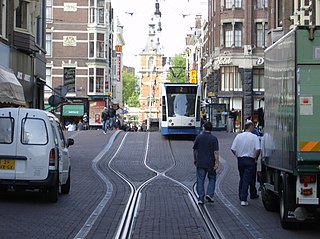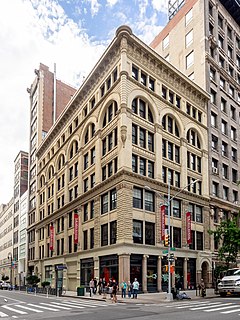Related Research Articles

An urban heat island (UHI) is an urban area or metropolitan area that is significantly warmer than its surrounding rural areas due to human activities. The temperature difference is usually larger at night than during the day, and is most apparent when winds are weak. UHI is most noticeable during the summer and winter. The main cause of the urban heat island effect is from the modification of land surfaces. Waste heat generated by energy usage is a secondary contributor. As a population center grows, it tends to expand its area and increase its average temperature. The term heat island is also used; the term can be used to refer to any area that is relatively hotter than the surrounding, but generally refers to human-disturbed areas.

Smart growth is an urban planning and transportation theory that concentrates growth in compact walkable urban centers to avoid sprawl. It also advocates compact, transit-oriented, walkable, bicycle-friendly land use, including neighborhood schools, complete streets, and mixed-use development with a range of housing choices. The term "smart growth" is particularly used in North America. In Europe and particularly the UK, the terms "compact city", "urban densification" or "urban intensification" have often been used to describe similar concepts, which have influenced government planning policies in the UK, the Netherlands and several other European countries.

In the engineering and social sciences, the term built environment, or built world, refers to the human-made environment that provides the setting for human activity, ranging in scale from buildings to cities and beyond. It has been defined as "the human-made space in which people live, work and recreate on a day-to-day basis."

Urban sprawl or suburban sprawl mainly refers to the unrestricted growth in many urban areas of housing, commercial development, and roads over large expanses of land, with little concern for urban planning. In addition to describing a particular form of urbanization, the term also relates to the social and environmental consequences associated with this development. In the postindustrial era, sprawl has entailed no clear-cut disadvantage, such as the loss of protection, nor resulted in a uniquely identifiable cost such as investment in new fortification, however its disadvantages and costs include increased travel time, transport costs, pollution, destruction of countryside, and so on. In Continental Europe, the term peri-urbanisation is often used to denote similar dynamics and phenomena, although the term urban sprawl is currently being used by the European Environment Agency. There is widespread disagreement about what constitutes sprawl and how to quantify it. For example, some commentators measure sprawl only with the average number of residential units per acre in a given area. But others associate it with decentralization, discontinuity, segregation of uses, and so forth.

Sustainable transport refers to the broad subject of transport that is sustainable in the senses of social, environmental and climate impacts. Components for evaluating sustainability include the particular vehicles used for road, water or air transport; the source of energy; and the infrastructure used to accommodate the transport. Transport operations and logistics as well as transit-oriented development are also involved in evaluation. Transportation sustainability is largely being measured by transportation system effectiveness and efficiency as well as the environmental and climate impacts of the system.
Land-use forecasting undertakes to project the distribution and intensity of trip generating activities in the urban area. In practice, land-use models are demand-driven, using as inputs the aggregate information on growth produced by an aggregate economic forecasting activity. Land-use estimates are inputs to the transportation planning process.

Suburbanization is a population shift from central urban areas into suburbs, resulting in the formation of (sub)urban sprawl. As a consequence of the movement of households and businesses out of the city centers, low-density, peripheral urban areas grow.
The California Environmental Quality Act (CEQA) is a California statute passed in 1970 and signed in to law by then-Governor Ronald Reagan, shortly after the United States federal government passed the National Environmental Policy Act (NEPA), to institute a statewide policy of environmental protection. CEQA does not directly regulate land uses, but instead requires state and local agencies within California to follow a protocol of analysis and public disclosure of environmental impacts of proposed projects and, in a departure from NEPA, adopt all feasible measures to mitigate those impacts. CEQA makes environmental protection a mandatory part of every California state and local (public) agency's decision making process. It has also become the basis for numerous lawsuits concerning public and private projects.

The Urban Land Institute, or ULI, is a nonprofit research and education organization with regional offices in Washington, D.C., Hong Kong, and London. Its stated mission is "to provide leadership in the responsible use of land and in creating and sustaining thriving communities worldwide". ULI advocates progressive development, conducting research, and education in topics such as sustainability, smart growth, compact development, place making, and workforce housing.
The Earth Institute is a research institute at Columbia University that was established at in 1995. Its stated mission is to address complex issues facing the planet and its inhabitants, with a focus on sustainable development. With an interdisciplinary approach, this includes research in climate change, geology, global health, economics, management, agriculture, ecosystems, urbanization, energy, hazards, and water. The Earth Institute's activities are guided by the idea that science and technological tools that already exist could be applied to greatly improve conditions for the world's poor, while preserving the natural systems that support life on Earth.
Environmental planning is the process of facilitating decision making to carry out land development with the consideration given to the natural environment, social, political, economic and governance factors and provides a holistic framework to achieve sustainable outcomes. A major goal of environmental planning is to create sustainable communities, which aim to conserve and protect undeveloped land.

Mixed-use development is a term used for two related concepts:

The Edward J. Bloustein School of Planning and Public Policy of Rutgers University serves as a center for the theory and practice of urban planning and public policy scholarship. The school is located in New Brunswick, New Jersey, and was named in honor of the former Rutgers University president, Edward J. Bloustein. Through its academic programs and research centers, the Bloustein School engages in instruction and research, and combines learning and application. The school's strengths and the specializations of its faculty are vast and many of its faculty members are the founders of theories or practices that are now commonplace in urban planning and policy. Areas of expertise for Bloustein faculty members include transportation planning and the environment, while others have specialties in policy. In 2018, a year long search for a new dean ended when Piyushimita (Vonu) Thakuriah was announced as dean. Dr. Thakuriah's experience in both transportation and data science and the launch of a new graduate degree in Public Informatics signal the schools readiness top tackle the increasing pace of government innovation in the 21st century.

Milano School of Policy, Management, and Environment is a graduate school at The New School within The Schools of Public Engagement that offers degrees in environmental policy and sustainability studies, nonprofit management, organizational change management, public policy and urban policy, as well as a PhD. program in public and urban policy and three graduate certificates.
The Furman Center for Real Estate and Urban Policy is a joint center at New York University School of Law and the NYU Wagner School of Public Service. The Furman Center was established in 1995 to create a place where people interested in affordable housing and land use issues could turn to for factual, objective research and information. Since that time, the Furman Center has become an authority on such matters in New York City. The Furman Center has a three-part mission, including providing objective academic research about land use, real estate, housing and urban affairs, with a particular focus on New York City, promoting intense debate and productive discussion among elected, academic, and industry leaders, and presenting essential data and analysis about the state of New York City's housing and neighborhoods.

Land recycling is the reuse of abandoned, vacant, or underused properties for redevelopment or repurposing.
Urban planning in Australia has a significant role to play in ensuring the future sustainability of Australian cities. Australia is one of the most highly urbanised societies in the world. Continued population growth in Australian cities is placing increasing pressure on infrastructure, such as public transport and roadways, energy, air and water systems within the urban environment.
Julian Wolpert is Bryant Professor Emeritus of Geography, Public Affairs, and Urban Planning at Princeton University's Woodrow Wilson School, where he taught from 1973-2005 and chaired the Program in Urban and Regional Planning. He was previously a member of the Regional Science Department at the University of Pennsylvania (1963–73). He is a graduate of Columbia University (BA) and the University of Wisconsin-Madison, MS & PhD (Geography). He served as a US Navy officer from 1956 to 1959. He was elected to the National Academy of Sciences and AAAS. He has been a fellow at the Russell Sage Foundation, the Center for Advanced Study in the Behavioral and Social Sciences, and the Woodrow Wilson Center and has been a Guggenheim fellow. Wolpert is a nationally cited scholar in the fields of location theory, urban development, migration, public and social services, and the analysis of charity, philanthropy, and the nonprofit sector, and has testified before Congress about the regulation of philanthropy. He has challenged conservatives who advocate for charitable rather than public service approaches to social policy. Wolpert served as Vice President, then President of the Association of American Geographers and Vice President of the Regional Science Association and the American Geographical Society and was elected to the American Institute of Certified Planners.
Vicki L. Been is an American lawyer, public servant, and professor. She is the Deputy Mayor of Housing and Economic Development for New York City and a former commissioner of the New York City Department of Housing Preservation and Development. She is a law professor at the New York University School of Law and has served as director of the Furman Center for Real Estate and Urban Policy.

Arthur C. Nelson is an American urban planner, researcher and academic. He is Professor of Urban Planning and Real Estate Development at the University of Arizona.
References
- ↑ "Center for Urban Policy Research ::: Welcome". Archived from the original on 2009-08-02. Retrieved 2009-08-16.
- ↑ "Study Weighs the Pros and Cons of Curbing Urban Growth". The New York Times . December 15, 1974. Retrieved March 13, 2010.
- ↑ Garbarine, Rachelle (August 3, 1997). "A New Report Tells Just How Preservation Pays". The New York Times . Retrieved March 13, 2010.
- ↑ "STUDY OUTLINES N.J.'S HOUSING NEEDS." Philadelphia Inquirer December 8, 1983.